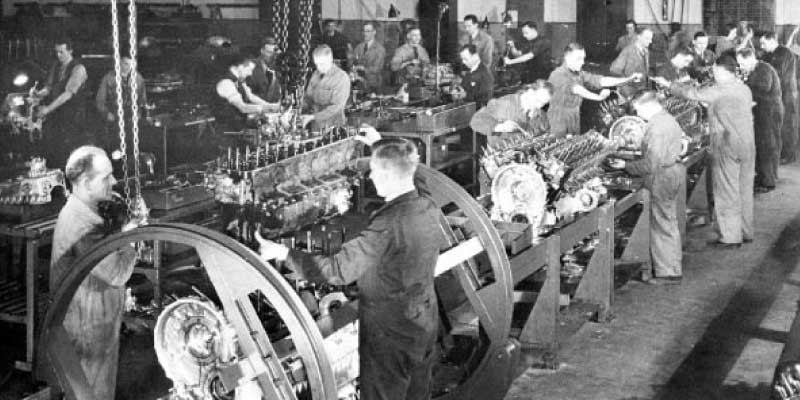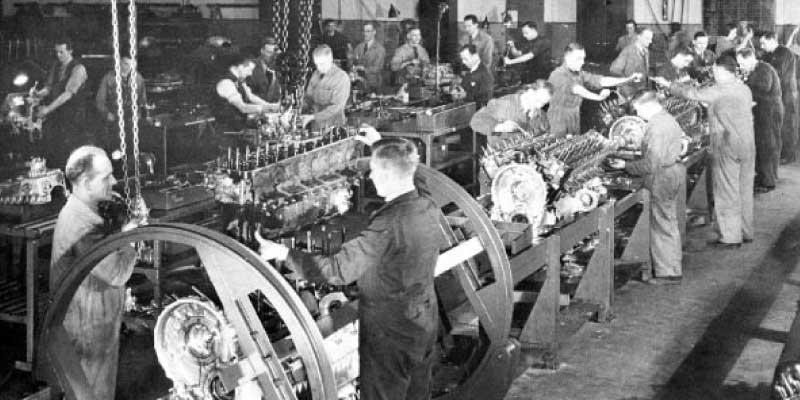Hoje em dia todos sabemos que as atividades econômicas afetam diretamente o modo de vida da população. Elas podem modificar a arquitetura, onde as construções se localizam e como são organizadas. As indústrias podem ser classificadas em: extrativas (produtos são utilizados por outras indústrias), de construção (relacionada à construção civil e naval) e de transformação (que transformam a matéria-prima em: bens de produção, bens intermediários ou de capital e, ainda, bens de consumo). As formas de produção de mercadorias passaram por um processo evolutivo. A primeira fase foi denominada artesanato (uma pessoa realizava todo o trabalho manualmente), a segunda etapa foi a manufatura (produção artesanal onde o trabalho era realizado por mais de um operário e separado em etapas) e a terceira etapa foi denominada maquinofatura (possibilita a produção em menor tempo de volume). A industrialização clássica ou tradicional ocorreu nos primeiros países que se industrializaram como foi o caso do Reino Unido, França e EUA. Já a industrialização planificada foi um modelo implantado pela União Soviética no início do século XX e aplicada em todos os países que se aliaram a URSS.
Reino Unido: Foi onde ocorreu a Primeira Revolução Industrial, pois apresentava as condições naturais e socioeconômicas ideias para o processo de industrialização. No início desse processo as indústrias se localizavam em sua maior parte próximo das reservas de carvão, logo depois o setor industrial foi se modernizando e se distribuindo por todo território inglês. O livro “Oliver Twist” demonstra situação em que viviam mostrando não só a revolução industrial como a pobreza da época.
- A região de Londres (capital da inglaterra), é a principal área industrial, além de outras cidades como Edimburgo e Glasgow;
- As vias de transporte contribuem para uma melhora nos processos de industrialização do Reino Unido que tem destaque em relação à produção industrial e ao comércio internacional.
- Hoje em dia o setor industrial inglês está relacionado à petroquímica, à química fina (destacando a farmacêutica), à energia nuclear, à indústria espacial e alimentícia.
França: Foi o segundo país a se industrializar. A produção industrial é muito diversificada, contendo empresas de importância mundial no setor automobilístico como a Renault e a Peugeot. O principal produto das indústrias é o Carvão. Seu parque industrial está bem distribuído, contendo 4 áreas principais, são elas:
- A região do entorno de Paris, com sua principal característica a grande diversidade na produção industrial;
- A região norte onde predominam os setores siderúrgico, metalúrgico, têxtil e químico;
- A região de Lyon onde predominam as atividades da mecânica, dos bens de produção, da eletrotécnica e da química;
- A região do nordeste, com extração de minérios, que concentram as indústrias químicas e siderúrgicas.
EUA: Sua industrialização está diretamente relacionada à chegada de imigrantes que vieram do Reino Unido e trabalhavam com a produção industrial, passando a desenvolver suas atividades principalmente na porção norte das Treze Colônias. A riqueza mineral possibilitou a sua entrada entre as principais economias mundiais.
- Os setores de investimento que os EUA mais investiram foram: o de pesquisa, o educacional e o tecnológico. Todos eles contribuíram para a evolução da produção industrial;
- Atualmente o território estadunidense é organizado em cinturões (tanto agrícolas quanto industriais). A produção industrial está localizada no cinturão da indústria ou da ferrugem (manufacturing belt) e no cinturão do sol (sun belt).
Outros países que se industrializaram durante a Segunda Revolução Industrial: Itália (ocorreu após sua unificação política e se intensificou com o Plano Marshall), Alemanha (ocorre desde o século XIX) e Japão (ocorreu no início da Era Meiji).
Fonte: Apostila SAE Digital 1, 9°ano.

Industrial Revolution
Nowadays, we all know that economic activities directly affect the way we live in society. They can modify the building’s architecture and where they are organized. Industries can be classified as: extractivist (products were used by other industries), construction (related to civil and naval construction) and transformation (which transform the raw material
into: production, intermediate or capital, and consumer goods). The ways how goods were produced went through an evolutionary process. The first phase was called handicrafts (one person performed all the work manually), the second phase was manufacturing (artisanal production where the work was carried out by more than one worker, separated in stages) and the third phase was called machining (which allowed the production in less volume time). Classical or traditional industrialization only occurred in the first countries that were industrialized such as the United Kingdom, France and the USA. Meanwhile the planned
industrialization was a model implemented by the Soviet Union at the beginning of the 20th century, and was applied in all URSS allied countries.
United Kingdom: It is where the First Industrial Revolution took place, as it presented the natural and socioeconomic conditions ideal for the industrialization process. At the beginning of this process, the industries were mostly located close to the coal reserves, shortly afterwards the industrial sector was modernized and distributed throughout English
territory. The book “Oliver Twist” demonstrates the situation in which they lived, showing not only the industrial revolution but the poverty of the time. Nowadays, the English industrial sector is related to petrochemicals, fine chemicals (especially pharmaceuticals), nuclear energy, space and food industry.
- London (capital of England), is the main industrial area, in addition to other cities such as Edinburgh and Glasgow;
- Transport routes contributed to an improvement in the industrialization processes in the United Kingdom, which stands out in relation to industrial production and international trade.
- Today the English industrial sector is related to petrochemicals, fine chemicals (highlighting pharmaceuticals), nuclear energy, space and food industry.
France: It was the second country to industrialize. It’s industrial production is very diverse, containing companies of world importance in the automotive sector such as Renault and Peugeot. The main production of industries is coal mining. It’s industrial park is well distributed, containing 4 main areas:
- The region around Paris, with its main characteristic, the great diversity in industrial production;
- The northern region where the steel, metallurgical, textile and chemical sectors predominate;
- The Lyon region where the activities of mechanics, production of goods,
electrotechnics and chemistry predominate; - The northeast region, with mineral extraction, which concentrates the chemical and steel industries.
USA: Its industrialization process is directly related to the arrival of
immigrants who came from the United Kingdom, who worked with industrial production, starting to develop their activities mainly in the northern portion of the Thirteen Colonies. Mineral wealth made it possible for it to enter among the main world economies.
- The sectors which the United States most invested were: research, education and technology. All of them contributed to the evolution of industrial production;
- Currently the American territory is organized in belts (both agricultural and industrial). Industrial production is located in the industry, rust belt (manufacturing) and in the sun belt.
Other countries that industrialized during the Second Industrial Revolution were: Italy (occurred after its political unification and intensified with the Marshall Plan), Germany (occurred since the 19th century) and Japan (occurred at the beginning of the Meiji Era).
Source: Apostila SAE Digital 1, 9°ano
Members of the group: André Ingechak Dallabona, Bruno Rodrigues Di Mario, Eduardo Pazini Sari, Henrique Kravchychyn Rodrigues, João Pedro Chaves Taets Garcia e Rafael Moreira Martins.

